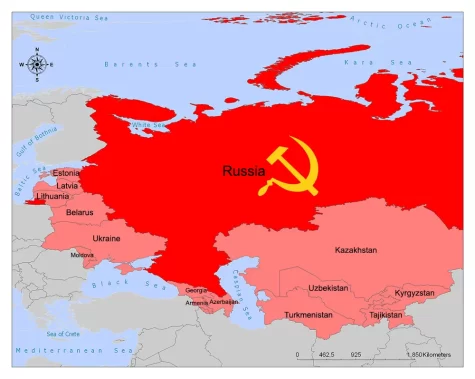The Bitter History of Russia and Ukraine
March 3, 2022
But why has Russia attacked Ukraine? While the two countries have had conflicts throughout history, the current conflict starts with the dissolution of the Soviet Union in 1991. The Soviet Union was a collection of countries under Russia’s sphere of influence under Vladimir Lenin, who led the Communist Revolution in Russia in 1917. Ukraine was a founding member of the Soviet Union when it was formed in 1922, but the country radically changed under Lenin’s successor Josef Stalin. Stalin was an autocrat who insisted that all Ukrainian people speak Russian instead of Ukrainian, that cities be renamed after Russian heroes, and that Ukrainian resources go directly to Moscow for distribution. Like everywhere else in the Soviet state, citizens lived under poor economic conditions while its leaders hoarded the wealth of its satellite nations and enforced its policies through the actions of the KGB, the hyper-militant Russian security force. Soviet dissidents would not only be brutally punished, but they would just disappear entirely–the KGB would edit photos and official documents to make it as if that person never existed.

Alarmed by the threat of the Soviet Union, America and the republics of Western Europe formed their own union–the North American Treaty Organization, or NATO. NATO countries were all bound by a pledge that an attack on one of the member countries was an attack on all, a pledge that kept the Soviet Union from directly confronting these nations. This “Cold War” saw NATO and the Soviets fight proxy wars in so-called third-world countries, i.e. the ones not part of NATO or the Soviet Union. These wars included the Korean War, the Vietnam War, and the British-Afghan War.
Eventually, after years of failing economic policies and corruption, the Soviet Union broke up, and nearly every member country became a democracy, including Ukraine and Russia. However, NATO was kept alive just in case a common threat to the member countries would ever rise again. Russian President Boris Yeltsin was very open with the West and wanted to make peace with his former enemies: through Yeltsin, Russia joined important global partnerships like the G8.
In 1999, Yeltsin left office because of term limits and was replaced by Vladimir Putin, a former KGB operative who still held hope that the Soviet Union would reform. Russia saw incredible growth under Putin, who served as President until 2008–like Yeltsin, he was blocked by term limits. Putin was soon elected as Russia’s Prime Minister (the head of Congress), and as PM, Putin radically changed Russian laws: he narrowed the scope of what media was allowed in the country, he put harsher restrictions on free speech, and he got rid of term limits for the President. Putin resumed the Presidency in 2012 and has been an autocrat ever since. While Russia still has elections, most of Putin’s political rivals are blocked from running, arrested, or die under unusual circumstances. In essence, he has become the 21st-century version of Josef Stalin.
Once Putin had control, he focused on getting the Union back together, as this would increase his own wealth and power. This proved tricky: the former Soviet countries seemed to really like democracy and self-governance and did not want to form a new Soviet state. Worse, some former Soviet countries joined the European Union and even wanted to join NATO. To stop this, Putin has funded pro-Russian groups in former Soviet countries and has waged cyber-terrorism against NATO countries, including the US. But when this didn’t work, Putin went to war.